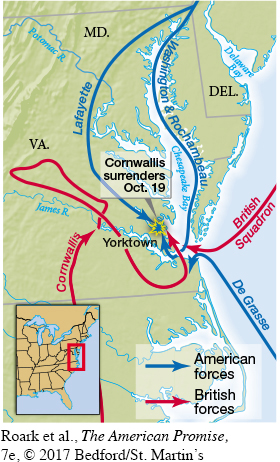The American Promise: Printed Page 190
The American Promise, Value Edition: Printed Page 176
The American Promise: A Concise History: Printed Page 200
Surrender at Yorktown
The American Promise: Printed Page 190
The American Promise, Value Edition: Printed Page 176
The American Promise: A Concise History: Printed Page 200
Page 190By early 1781, the war was going very badly for the British. Their defeat at King’s Mountain was quickly followed by a second major defeat at the battle of Cowpens in South Carolina in January 1781. Cornwallis retreated to North Carolina and thence to Virginia, where he captured Williamsburg in June. A raiding party proceeded to Charlottesville, the seat of government, capturing members of the Virginia assembly but not Governor Thomas Jefferson, who escaped the soldiers by a mere ten minutes. (The slaves at Monticello, Jefferson’s home, stood their ground and saved his house from plundering, but more than a dozen at two other plantations he owned sought refuge with the British.) These minor victories allowed Cornwallis to imagine he was succeeding in Virginia. His army, now swelled by some 4,000 escaped slaves, marched to Yorktown, near the Chesapeake Bay area. As the general waited for backup troops by ship from British headquarters in New York City, smallpox and typhus began to set in among the black recruits.

At this juncture, the French-
On land, General Cornwallis and his 7,500 troops faced a combined French and American army of 16,000. For twelve days, the Americans and French bombarded the British fortifications at Yorktown; Cornwallis ran low on food and ammunition. He also began to expel the black recruits, some of them sick and dying. A Hessian officer serving under Cornwallis later criticized this British action as disgraceful: “We had used them to good advantage, and set them free, and now, with fear and trembling, they had to face the reward of their cruel masters.” The twelve-
The American Promise: Printed Page 190
The American Promise, Value Edition: Printed Page 176
The American Promise: A Concise History: Printed Page 200
Page 191What began as a promising southern strategy in 1778 had turned into a discouraging defeat. British attacks in the South had energized American resistance, as did the timely exposure of Benedict Arnold’s treason. The arrival of the French fleet sealed the fate of Cornwallis at the battle of Yorktown, and major military operations came to a halt.